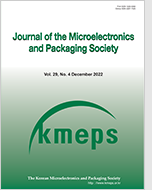
Search
- Past Issues
- e-Submission
-

KCI Accredited Journals KCI 등재지
KCI Impact Factor 0.54
Editorial Office
- +82-2-538-0962
- +82-2-538-0963
- kmeps@kmeps.or.kr
- http://kmeps.or.kr/

KCI Accredited Journals KCI 등재지
KCI Impact Factor 0.54
Journal of the Microelectronics and Packaging Society 2024;31(3):72-79. Published online: Oct, 30, 2024
DOI : doi.org/10.6117/kmeps.2024.31.3.072
To realize high speed and high bandwidth in the 2.xD package structure, methods requiring high technology are being studied for processes such as interposer or bridge die bonding, as well as heterogeneous chip bonding. Particularly, the grinding process of bonding surfaces is considered a key technology. The method of bonding an interposer or bridge die including Cu layers to a substrate and then exposing metallic materials such as Cu, which can be electrically connected, through a grinding process to connect heterogeneous chips is an approach that utilizes conventional packaging techniques. However, to meet the yield and quality standards required for mass production in processes involving the largescale bonding of micro-bumps, as seen in 2.xD packages, it is essential to develop techniques based on high precision. This paper investigates the multi-material grinding process for heterogeneous chip bonding in a 2.xD package structure, using the grit size of the grinding wheel as a variable. The study examines the surface patterns and bonding characteristics of the exposed materials achieved through the grinding process. Through this study, we aim to optimize the grinding process for high-quality bonding, thereby contributing to the development of advanced packaging technologies.
Keywords 2.xD packaging, Package grinding, Surface patterns, Bonding characteristics